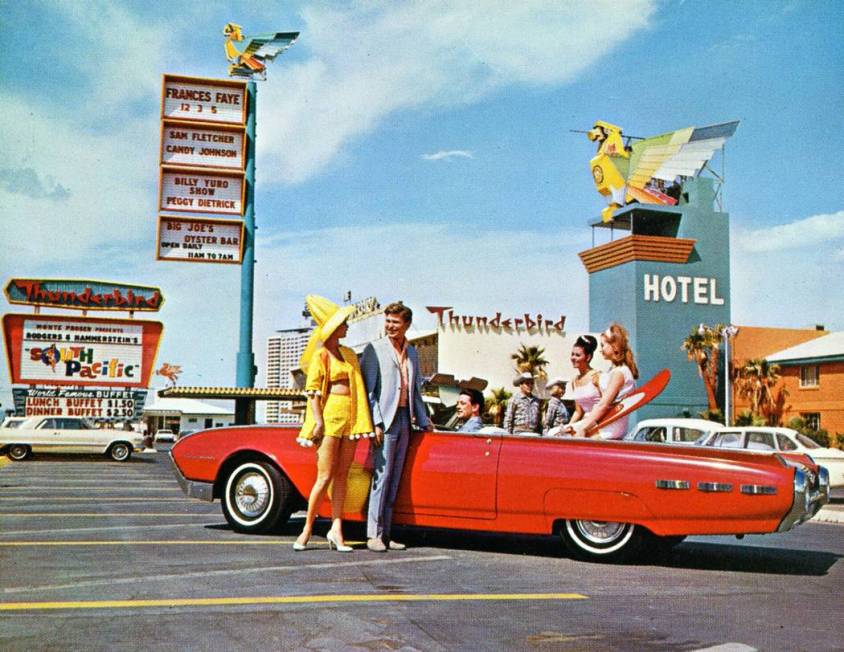Las Vegas history book a visual feast of old photos

When Peter Moruzzi drove back home after his first visit to Las Vegas, it was with a suitcase full of postcards, matchbooks and ashtrays.
The year was 1983, and the 21-year-old had fallen in love with the city, its architecture, its neon and the downtown area where he learned to play craps.
In his book, “Greetings From Las Vegas” (Gibbs Smith, $30), Moruzzi visually chronicles Las Vegas’ history using his own artifacts, Kodachromes he purchased at swap meets, and photos he uncovered in museum collections.
“I was knocked out by the beauty of Las Vegas,” Moruzzi recalls. “I had written other similar books and wanted to do one on Las Vegas.”
Moruzzi realizes that the Las Vegas history book has been done before. But he set out to do something different by including over 300 images, many of which he thinks will be new even to Las Vegas history aficionados such as himself.
His book examines Las Vegas’ evolution from a dusty railroad town in the early 1900s, through gambling legalization in 1931, the days of the mob, Rat Pack, the tiki bar and beyond.
Moruzzi has authored pictorial history books of Los Angeles, Havana and his current home, Palm Springs, California. He also drafted the successful nomination to place Las Vegas’ El Cortez in the National Registry of Historic Places.
In the early stages of creating the book, Moruzzi sought out photos that he hadn’t seen in other publications.
He sourced photos from new collections, including a Young Electric Sign Co. archive belonging to the Neon Museum and photos belonging to UNLV’s special collections.
“There’s a mock-up of Vegas Vic that hasn’t been seen before from the YESCO archive,” Moruzzi says.
He was especially interested in candid photos of ordinary people, rather than the more common posed and promotional images that have survived through today.
He cites a Kodachrome of three Las Vegas visitors named Flo, Frank and Betty, gathered around a bed at the Dunes, divvying up their slot machine winnings.
“I wanted to include Kodachromes of ordinary people having a good time,” he says.
During his yearly trips to Las Vegas, he scoured swap meets, antique malls and eBay for postcards and memorabilia.
One of his favorite images from his personal collection is a 1946 postcard of the Flamingo, bearing a vertical marquee that only stood for a few months before being redesigned.
“We would always go to famous places like Hugo’s Cellar and Golden Steer Steakhouse,” Moruzzi says. “I once talked my way into the Neon Boneyard by saying I was a Hollywood film scout.”
Moruzzi conducted most of his research while writing the nomination for the El Cortez. He also consulted friends and fellow historians, two of whom are included in the book as contributing authors.
He landed on two themes that he says demonstrate the story of Las Vegas.
“One is the extremely rapid growth from 1946 to 1960,” he says. “These hotels sprouting every year, sometimes two a year. It was a short period of time for this new concept to pop up from the desert sands.”
The other theme he focused on was modernism, specifically how post-World War II style influenced Las Vegas hotels and casinos.
“They had the best architects, locally and from the rest of the country, working on them,” he says.
On Thursday, Moruzzi will host a slideshow of historical highlights and a book signing in the Wayfarer Theater at Inspire in downtown Las Vegas.
“Visually, Las Vegas is one of the best places on Earth,” Moruzzi says. “Without these early pioneers and things they came up with, we would never have the World Series of Poker or free cocktails. It’s necessary that people understand how Las Vegas came to be what it is.”
Contact Janna Karel at jkarel@reviewjournal.com. Follow @jannainprogress on Twitter.